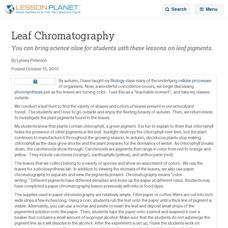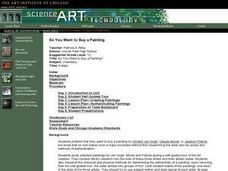Curated OER
Chromatography
Students conduct various experiments on chromatography. In this chemistry lesson, students distinguish among the different types of chromatography methods. They explain how the stationary and mobile phase interact with each other.
Curated OER
Chromatography Lab
Students discover the components of primary and secondary colors. In this physical science lesson, students create a set up in which water will separate a color into the component colors along a piece of filter paper. Students will then...
Curated OER
When Trees Are Red, Color in Remote Sensing
Student learn about "chromatography" in a hands-on experiment. Students make a chart showing what the colors represent.
Curated OER
Leaf Chromatography
You can bring science alive for students with these lessons on leaf pigments.
Curated OER
Plant Pigment Chemistry
Young scholars discover the roles of pigments present in leaves. They extract and isolate pigments present in autumn leaves using a thin layer chromatography. Very nice lesson and lab!
Curated OER
Science: Pigments and Photosynthesis
Students explore the process of photosynthesis by identifying chloroplasts and chlorophyll pigments. In a demonstration, they observe a demonstration connecting pigments with sunlight conversion into energy. Using paper chromatography,...
Curated OER
Straw Chromatography
Students separate food coloring using liquid chromatography. In this chemistry lesson, students explain the effects of different solvents on the rate of separation.
Curated OER
Chromotography
In this chromatography worksheet, students are given markers, filter paper and a solvent to separate the pigments found in each marker. Students create a chromatogram for each marker.
Curated OER
Thin Layer Chromatography (TLC) Separation of Plant Pigments - Chlorophyll, Carotene
Learners use TLC separations to identify various substances. In this chlorophyll lesson students separate pigments found in different plants.
Curated OER
Plant Pigments
Students investigate the components of chlorophyll. They use paper chromatography to separate the many pigments of chlorophyll from one another.
Curated OER
Flower Pigments
Pupils experiment with Thin Layer Chromatography to separate pigments found in flower petals.
Curated OER
Color Change in Leaves
Students identify the different leaf pigments and colors. In this biology lesson, students perform chromatography to separate them. They explain how light affects green leaf colors and causes falling leaves in autumn.
Curated OER
Can Chromatography Separate A Pigment?
Students separate a mixture of pigments with ion exchange chromatography and predict whether the ion-exchange matrix is positively or negatively charged based on the type of pigment bonded to the matrix.
Curated OER
Thin-layer chromatography
Students produce chromatograms of various vegetable extracts and standards. Using a flat bed scanner, they create a database of the results.
Curated OER
Cell Structures and Their Functions
Life science learners investigate live cells. They examine wet mount slides of cyanobacteria and Elodea plants. They peer into the dynamic microscopic world of protists. Afterward, they construct a model of a cell, including rudimentary...
Curated OER
Investigating The Mysteries Of Third Grade
Third graders use logic and knowledge of mathematics facts to solve problems. They see that pigments can be broken down into separate colors. Pupils recognize the capacity of water to move upward and measure the height water travels up...
Curated OER
Molecular Evolution in Plants
Learners examine chlorophylls. They explore the absorbing pigments in a variety of plants. Through activities, students determine spectrophotometrically. They compare plant proteins from the family Brassicace to assess the level of...
Curated OER
Molecular Evolution in Plants
High schoolers are using a paper chromatography study that is suitable for introductory biology. The absorption spectra studies and gel electrophoresis studies are appropriate for students who have complete both introductory biology and...
Curated OER
Chlorophyll
Students use thin layer chromatography, TLC, to separate various pigments found in plants.
Alabama Learning Exchange
What Color Are The Leaves?
Young scholars identify the colors in leaves. In this chromatography lesson, students read the book Why Do Leaves Change Color? and construct chromatography strips to identify the colors of leaves.
Curated OER
Photosynthesis
Students assess and experiment with the role of plant pigments in photosynthesis. They relate the basic principles of photosynthesis utilizing paper chromatography to evaluate a hypothesis regarding plant pigments as well as the role of...
Curated OER
Chlorophyll
Students explain the importance of chlorophyll in plants. In this biology lesson, students extract chlorophyll from different plant sources using chromatography. They discover the different factors needed for photosynthesis to take place.
Curated OER
Characterizing Drosophila Mutants
Learners investigate wild-type and several mutant varieties of Drosophila melanogaster, which are characterized and distinguished according to pteridine pigments. They discoverthat paper chromatography of the wild-type Drosophila results...
Curated OER
So You Want to Buy a Painting
Twelfth graders research physical and chemical methods used in authenticating paintings (e.g., ultraviolet fluorescence and spectroscopy, infrared spectroscopy and reflectography, X-ray diffraction, microscopy, pigment analysis, and gas...

























